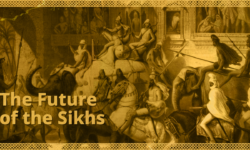
The concept of the state, as reflected in Sikh scriptures and history, is rooted in a unique fusion of political and spiritual philosophy. This integration is embodied in the doctrine of Miri-Piri, which reflects the religious responsibility within political affairs. Sikh religion and history encompass both Miri (temporal authority) and Piri (spiritual authority), the foundations of which were laid by the Sikh Gurus, who were both spiritual guides and political leaders.
The terms Miri and Piri originate from the Persian words Mir and Pir, respectively.
• Mir refers to an emperor, prince, lord, governor, chief, or leader—essentially someone who holds temporal authority. The term Amir carries a similar meaning, denoting one who possesses wealth and power.
• Pir denotes a guru, teacher, spiritual guide, saint, or the founder of a religion.
Thus, Miri and Piri represent temporal and spiritual powers, respectively—two vital dimensions of human life that together constitute the totality of reality. According to the principle of Miri-Piri, these aspects are inseparable. This principle highlights a creative, integrative, and life-affirming vision of reality that is essential for the full development of human personality.
In Gurbani, the term Mir is used to denote a person of power. While the Mir—a ruler—is mortal and holds temporal authority, the Pir, as a bearer of spiritual power, is regarded as immortal. The Pir exemplifies a way of life characterized by renunciation, self-sacrifice, detachment, and spiritual excellence. Pirs are often equated with prophets and apostles. Guru Nanak referred to Emperor Babar as a Mir due to his political status, while Bhai Gurdas used the term Pir for Guru Nanak to emphasize his divine and spiritual qualities. Similarly, Kahan Singh Nabha, in his Mahan Kosh, interprets Mir as an abbreviation of Amir, and defines Pir as a person of marked divinity.
The concept of Miri-Piri, therefore, signifies the blending of worldly and spiritual sovereignty. This fusion is rare in Indian history and contrasts sharply with prevailing notions that separate spiritualism from political power. For this reason, some scholars find it difficult to accept that the pursuit of political power—even for noble purposes—can be a legitimate spiritual undertaking.
Before the time of Guru Hargobind, the sixth Sikh Guru, the Gurus’ authority was viewed as purely spiritual. Guru Nanak Dev was known as Nanak Shah Faqir, revered as the Guru of Hindus and the Pir of Muslims. However, after the execution of Guru Arjan Dev by Emperor Jahangir on charges of rebellion, the responsibility of Guruship fell upon his eleven-year-old son, Guru Hargobind. In his final message to his son, Guru Arjan instructed him to fully arm himself and prepare for a long struggle against tyranny.
Following this command, Guru Hargobind introduced a revolutionary change in the concept of Guruship. Upon ascending to his role, he wore two swords—one symbolizing Piri (spiritual authority), and the other symbolizing Miri (temporal authority). Thus, he embodied both spiritual greatness and worldly sovereignty. This marked a significant transformation, echoing the Indic philosophy of Raj-Dharma, and it carried profound implications for the future of Sikhism.
At his installation ceremony, presided over by Baba Buddha, Guru Hargobind requested the traditional seli (rosary) and topi (skull-cap)—symbols passed from one Guru to another—to be replaced with a sword. Baba Buddha placed a sword on the Guru’s right side, but when he attempted to correct what he thought was a mistake, Guru Hargobind asked him to bring a second sword and place it on his left side. One sword represented Piri, the spiritual domain, and the other Miri, the temporal domain. Additionally, Guru Hargobind wore an aigrette (a plume) on his turban as a symbol of royalty.
“My rosary shall be the sword-belt, and on my turban I shall wear the emblem of royalty.”
Similar accounts of his appointment are found in Santokh Singh’s Guru Pratap Suraj Granth and Kesar Singh Chhibber’s Bansavali Nama.
Guru Hargobind came to be known among Sikhs as the Sacha Patshah (True King). He issued hukamnamas (edicts) encouraging Sikhs to bear arms and ride horses, even offering double blessings to those who gifted weapons or horses to the Guru. He also hired professional soldiers to train Sikhs in martial arts and took part in hunting and athletic games. This marked a dramatic shift in the lifestyle of the Guru and his followers.
The concept of Miri-Piri, fully developed and emphasized by Guru Hargobind, became central to Sikh philosophy and history. Though it came to prominence during his Guruship, the idea had always been a part of the teachings of the earlier Gurus. The emphasis on integrating worldly responsibility with spiritual development began with Guru Nanak and reached its culmination with the formation of the Khalsa by Guru Gobind Singh. The socio-political circumstances during Guru Hargobind’s time, however, brought this doctrine into sharp focus and made it a defining feature of Sikh identity.
-Dr. Gurdeep Kaur









